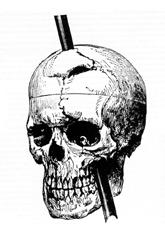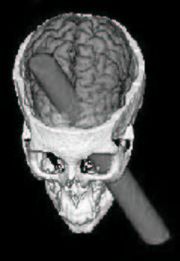Phineas Gage
2008/9 Schools Wikipedia Selection. Related subjects: Health and medicine
| Phineas P. Gage | |
 Life mask of Phineas Gage, c.1850
|
|
| Born | July 9?, 1823 |
|---|---|
| Died | May 21?, 1860 |
| Occupation | Railroad construction |
| Neuropsychology |
|---|
| Topics |
|
Brain-computer interface • Traumatic brain injury |
| Brain functions |
|
arousal • attention |
| People |
|
Arthur L. Benton • David Bohm |
| Tests |
|
Bender-Gestalt Test |
| Tools |
|
Johari Window |
| Mind and Brain Portal |
Phineas P. Gage (July 9?, 1823 – May 21?, 1860) was a railroad worker now remembered for his incredible survival of a traumatic brain injury which destroyed one or both of his frontal lobes, and for the injury's reported effects on his personality and social functioning—effects said to be so profound that friends said he was "no longer Gage." His case played a role in the development of the understanding of the localization of brain function, and was among the first to suggest that damage to the frontal lobes can affect personality and behaviour.
Family
Phineas Gage was born around July 9, 1823, likely in Lebanon, New Hampshire, the son of Jesse Eaton Gage and Hannah Trussell (Swetland) Gage, and died in California on May 20 or 21, 1860, possibly in San Francisco. His physician's references to his family make no mention of a spouse or children.
Gage's accident
On September 13, 1848, Phineas Gage was foreman of a work gang blasting rock while clearing the roadbed for a new rail line outside the town of Cavendish, Vermont. After a hole was drilled into a body of rock, one of Gage's duties was to add gunpowder, a fuse, and sand, then tamp the charge down with a large iron rod. Possibly because the sand was omitted, around 4:30 P.M. "the powder exploded, carrying an instrument through his head an inch and a fourth in circumference[ sic], and three feet and eight inches in length, which he was using at the time. The iron entered on the side of his face, shattering the upper jaw, and passing back of the left eye, and out the top of his head." (In fact, the iron was 1-1/4 inches in diameter, not circumference as given in the item at left -- from the Boston Post for September 21, reprinting an earlier report in the Ludlow [Vermont] Free Soil Union -- and was three feet seven inches long.) Weighing 13-1/4lb (6 kg), the rod was said to have landed some 80 feet (25 meters) away.
Amazingly, Gage spoke within a few minutes, walked with little or no assistance, and sat upright in a cart for the 3/4-mile ride to town. Though physicians Edward H. Williams and John Martyn Harlow found him weak from hemorrhage, he had a regular pulse of about 60 and was alert and coherent.
Physical recovery
Both medicine and common sense dictate that passage through the forebrain of a projectile 1-1/4 inches in diameter should almost certainly be fatal, due to the probable damage to vital vascular structures such as the superior sagittal sinus. But the rod did not emerge exactly at the midline, so may have missed the sinus by passing beneath it; and the fact that it tapered to a 1/4-inch point at the leading end may have reduced its destructiveness.
On initial examination, Gage's left pupil was reactive to light, suggesting that the iron had passed laterally to the left optic nerve. Whether the damage was to both frontal lobes, or just the left, is uncertain. Studies by Hanna Damasio and colleagues suggest bilateral damage to the medial frontal lobes, but a recent study by Ratiu and colleagues, based on a CT scan of Gage's skull, suggests that Gage's injury was more limited.
Despite Harlow's skillful care, Gage's recuperation was long and difficult. A "fungal" infection left him semi-comatose from September 23rd to October 3rd, "seldom speaking unless spoken to, and then only answering in monosyllables." On October 7 he took his first step. On October 20th Dr. Harlow described Gage as "very childish," and while Harlow was absent for a week, Gage was "in the street every day except Sunday," his desire to return to his family in Lebanon, New Hampshire being "uncontrollable by his friends." He promptly developed a fever, but by mid-November he was "feeling better in every respect...walking about the house again; says he feels no pain in the head." Harlow's final prognosis in his contemporary (1848) case report was that Gage "appears to be in a way of recovering, if he can be controlled".
Subsequent life and travels
Except for loss of vision in the left eye, some facial paralysis, and probably severe facial disfigurement, Gage's physical recovery was apparently complete. By around the middle of 1849 he felt strong enough to resume work, but his employers refused to return him to his previous position, allegedly because of mental changes (see below).
Harlow says that Gage was for a time an attraction at P. T. Barnum's New York museum, putting his injury (and the tamping iron which caused it) on display, though there is no independent confirmation of this. He later worked in a livery stable in New Hampshire and then for some years in Chile, probably as a coach driver. When his health failed in 1859, he left Chile for San Francisco, where he recovered under the care of his mother and sister (who had moved there from New Hampsire about the time Phineas went to Chile). For some months before his death he did farm work in Santa Clara.
Death and subsequent travels
In February of 1860, Gage had the first in a series of increasingly violent convulsions, and he died in May of that year. He was buried in San Francisco's Lone Mountain Cemetery.
In 1866, Dr. Harlow somehow learned where Phineas had been, and opened a correspondence with his family, still in San Francisco. At his request they exhumed Phineas' skull. Soon after the accident, Phineas had given the tamping iron which injured him to Harvard's Dr. Bigelow, but he later reclaimed it and (according to Harlow) made it his "constant companion during the remainder of his life"; now it and the skull were delivered to Harlow back in New England. After studying them for an 1868 paper, he in turn donated them to the Harvard Medical School's Warren Anatomical Museum in Boston, where they remain on display today.

The rod bears an inscription: "This is the bar that was shot through the head of Mr. Phinehas [ sic] P. Gage at Cavendish, Vermont, Sept. 14, [ sic] 1848. He fully recovered from the injury & deposited this bar in the Museum of the Medical College of Harvard University. Phinehas P. Gage Lebanon Grafton Cy N-H Jan 6 1850".
Much later, Phineas' headless skeleton was moved to Cypress Lawn Cemetery, south of San Francisco, as part of a general transfer of remains out of the city.
Mental changes
The extent of the effect of Gage's injury on his mental state is uncertain. In An Odd Kind of Fame: Stories of Phineas Gage, psychologist Malcolm Macmillan shows that accounts that have entered both scientific and popular discourse are varying and inconsistent, typically poorly supported by the available evidence, and sometimes in direct contradiction to it. For example Dr. Harlow, writing in 1868 while in contact with Phineas' mother, gives the year of Gage's death as 1861, whereas Macmillan shows conclusively that Gage died in 1860—a striking (if relatively unimportant) illustration of the uncertainty of almost all we know about Gage.
More significantly for Gage's place in the history of neuroscience and related fields, almost nothing is known about his pre-injury personality and behaviour, and the descriptions offered after his death of post-injury changes are much more dramatic than anything reported while he was alive. In his initial (1848) report, Harlow mentioned psychological symptoms only in passing. And after observing Gage for several weeks, Henry Jacob Bigelow, Professor of Surgery at Harvard University, wrote in 1850 that Gage was "quite recovered in faculties of body and mind."
It was Harlow's second report, written after he obtained Phineas' skull in 1868 (eight years after Gage's death and twenty years after the accident) that introduced the now-textbook mental changes. Now Harlow described the pre-accident Gage as having been hard-working, responsible, and popular with the men in his charge, but the post-accident Gage as
fitful, irreverent, indulging at times in the grossest profanity (which was not previously his custom), manifesting but little deference for his fellows, impatient of restraint or advice when it conflicts with his desires, at times pertinaciously obstinate, yet capricious and vacillating, devising many plans of future operations, which are no sooner arranged than they are abandoned in turn for others appearing more feasible. A child in his intellectual capacity and manifestations, he has the animal passions of a strong man. Previous to his injury, although untrained in the schools, he possessed a well-balanced mind, and was looked upon by those who knew him as a shrewd, smart businessman, very energetic and persistent in executing all his plans of operation. In this regard his mind was radically changed, so decidedly that his friends and acquaintances said he was 'no longer Gage.'
Later writers embellished Harlow's comments, adding drunkenness, braggadocio, a vainglorious tendency to show off his wound, an utter lack of foresight, and much more — all unmentioned by Harlow.
The ambiguity of the evidence has allowed, as Macmillan puts it, "the fitting of almost any theory to the small number of facts we have." Thus, in the 19th-century controversy over whether or not various mental functions are localized in specific regions of the brain, both sides found ways to cite Gage in support of their positions. (Adherents of phrenology made use of Gage as well, claiming that his mental changes stemmed from destruction of his "Organ of Veneration" and/or the adjacent "Organ of Benevolence.")
Neurologist Antonio Damasio's somatic marker hypothesis suggests a link between the frontal lobes, emotion and practical decision-making. He sees Gage's story as crucial in the history of neuroscience, arguing that it provided "the historical beginnings of the study of the biological basis of behaviour".
It is often said that Gage's case inspired the development of frontal lobotomy, but careful inquiry refutes this claim; Macmillan states that, "The most that the Gage case indicated was that radical operations on the brain were possible."

